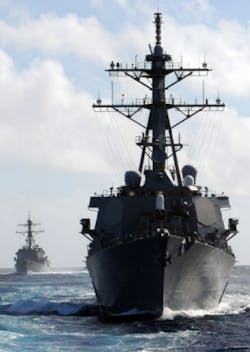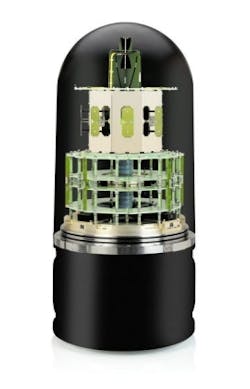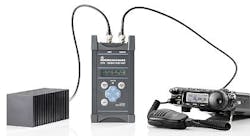Reliable military and aerospace communications depend on advanced military antenna technologies
Optimal antenna
“The antenna is a system’s key component. Poor antenna performance cannot be compensated by any other equipment in the system,” Fischer adds. A growing awareness of this fact is evident among systems designers and end users; today, they seek “optimized antennas in a much stronger way than they did years before.”
Engineers increasingly stress the importance of defining antenna specifications that are optimally adjusted to the overall system performance. Fischer and his colleagues at Rohde & Schwarz’s antenna design department, which has more than 50 years of antenna design experience, help to realize antennas that “integrate superior specifications as well as comply with the harshest environmental data,” he says.
Breadth on the battlefield
Advanced antenna technology is employed throughout myriad mil-aero environments for a multitude of missions today. Engineers stress the importance of selecting the right antenna for the specific mil-aero system and application from the wealth of advanced antenna options available from leading technology firms.
The Rohde & Schwarz product line, for example, “encompasses a wide range of highly sensitive active and passive, omnidirectional and directional, and broadband antennas for mobile and stationary use, providing complete coverage of the 100 Hz to 40 GHz frequency range,” Fischer explains. The company provides antenna solutions for land-based, naval, and airborne communications, as well as communications intelligence (COMINT) and electronic warfare (EW) systems for communications electronic support measures (CESM) and communications electronic countermeasures (CECM). “Besides our extensive standard program of antennas, we are offering solutions for submarines, airborne applications, DF antennas and special antenna systems,” he adds.
Rohde & Schwarz Australia is delivering R&S M3SR Series 4100 and R&S M3SR Series 4400 software-defined radios, as well as associated filters/combiners and antennas, fitted into racks for installation in the ships’ hulls. The first of the three AWDs to be built is the HMAS Hobart, currently under construction and scheduled for delivery to the Royal Australian Navy in Dec. 2014. The HMAS Brisbane and HMAS Sydney are scheduled for delivery in 2016 and 2017, respectively.
The AWDs, built around the Aegis weapon system and AN/SPY 1D(V) phased array radar, will carry the SM-2 missile; a helicopter for surveillance and response to support key warfare areas; long-range, anti-ship missiles and a naval gun capable of firing extended range munitions in support of land forces; and modern sonar systems, decoys, surface-launched torpedoes, and an close-in defensive weapons for undersea warfare. All system integration activities are being conducted at the Rohde & Schwarz Australia plant in Sydney.
Rohde & Schwarz engineers in Germany are developing commercial off-the-shelf (COTS) products appropriate to a new line of VHF/UHF communication antennas for use onboard ships, including the German Navy’s latest frigates. “The new antenna concept allows the combining of, for example, 10 individual VHF/UHF communication lines to just one antenna,” Fischer explains. “It offers the advantage of having less antennas onboard ships and, thus, avoiding negative influence in between these antennas. The overall performance of the antenna, with respect to omnidirectional coverage, has dramatically increased due to optimized radiation patterns.”
On the move
“The most active area of antenna technology development today is in SATCOM-on-the-move (SOTM) for land, sea, and airborne applications. Military and aerospace users are keenly interested in developing applications for SOTM technology,” notes Marvin Shoemake, vice president of business development, General Dynamics SATCOM Technologies in Duluth, Ga.
General Dynamics SATCOM Technologies has sold more than 200 SOTM terminals to U.S. Department of Defense (DOD) organizations--including the Army, Marine Corps, Navy, and specialized users -- and commercial customers worldwide. In fact, “SATCOM Technologies pioneered the successful use of small antennas combined with gimbaled terminals to provide consistent high-bandwidth communications via constant contact with orbiting satellites even when the terminal is mounted on a vehicle moving over rough terrain, on a ship at sea, or fixed to an aircraft banking in flight," Shoemake says.
The company provides antennas ranging in size from 13 to 30 inches in diameter for use with X-, Ku-, and Ka-band terminals. “As for frequency bands, right now Ku-band is the most popular along with X-band; but, when the Wideband Global SATCOM System (WGS) deploys, use of Ka band will grow, especially with the U.S. DOD,” Shoemake explains.
“Going forward, the parabolic-designed antenna will continue to be the mainstay for SOTM terminals because of its efficiency," Shoemake predicts.“ "We’ve investigated the use of flat-panel antenna designs for SOTM, but it has drawbacks; the most significant is the ‘look’ angle, where the gain drops off as the terminal moves and, as a result, the terminal can only support a lower data rate. SATCOM Technologies will continue to reduce costs and improve power efficiency in all our communications terminals but today’s parabolic antenna design will probably be around for a while.”
General Dynamics SATCOM Technologies won a $40.7 million contract from the National Aeronautics and Space Administration’s (NASA’s) Jet Propulsion Laboratory (JPL) to build two additional 34-meter-wide (112-foot) beam waveguide antennas. The new antennas, to be located at the Deep Space Network (DSN) facility in Canberra, Australia, are part of NASA’s modernization and transformation plan to continue scientific studies of the Earth and to explore distant bodies in the solar system.
“This contract, combined with General Dynamics’ continuing work to modernize the space administration’s ground systems, meets NASA’s critical need for seamless upgrades to communications and network infrastructure, while maintaining mission critical operations,” says Gary Kanipe, vice president of General Dynamics SATCOM Technologies. The antennas, originally designed by JPL and built by General Dynamics, enable the Deep Space Network to communicate with and support existing spacecraft missions (such as the Mars Exploration Rovers, Spitzer Space telescope, and Saturn explorer Cassini), radar and radio observatories that explore the solar system and universe, and future NASA space missions.
The company has built nine 34-meter, beam waveguide-style antennas housing sensitive electronics and systems in a room inside of the antenna’s ground-based pedestal for NASA’s DSN. Construction, integration, and testing for the two new antennas, designated Deep Space Stations 35 and 36, are scheduled for completion by 2014 and 2016, respectively.
NASA’s DSN collection of antennas is spread across three DSN facilities located 120 degrees apart, in California, Spain, and Australia. “This strategic placement enables constant observation and communication as the Earth rotates, making the Deep Space Network one of the largest and most sensitive scientific telecommunications systems in the world,” says a spokesperson.
Public safety
General Dynamics SATCOM Technologies won an $80 million contract from Harris Corp. to design, manufacture, and install six new 16-meter antennas and upgrade four 9-meter satellite communications antennas in support of the National Oceanic and Atmospheric Administration’s (NOAA’s) Geostationary Operational Environmental Satellite R-series (GOES-R) program.
The antennas will enable critical command, control, telemetry, and sensor data communications between satellites and ground stations for timely and accurate weather forecasting, severe storm tracking, and meteorology research. GOES satellite and ground antenna systems deliver a continuous stream of environmental data to enable forecasters to detect, track, and observe global weather patterns and meteorological phenomena that can directly affect public safety, protection of property, and economic health and development.
The new antennas will be installed at the NOAA Wallops Command and Data Acquisition Station in Wallops, Va., with a remote backup site in Fairmont, W.Va. The antenna deliveries will be aligned with the first GOES-R satellite launch, scheduled for 2015. SATCOM Technologies’ subcontractor, Nexcom Inc. of Melbourne, Fla., will provide high-power amplifiers to the program.
SATCOM surveillance
Military communications experts at Science Applications International Corp. (SAIC) in McLean, Va., chose EMS Defense & Space in Norcross, Ga., to provide an X-band satellite communications (SATCOM) antenna system for the U.S. Army RC-12X Guardrail signals-intelligence aircraft, a military version of the Beechcraft Super King Air 200 twin-engine turboprop being built by Northrop Grumman. EMS Defense & Space antenna designers adapted the company’s X-band SATCOM antenna system by converting the EMS Wavestorm GS-X antenna to an airborne version, called the Wavestorm AS-X, for the application.
“The antenna has undergone several demonstrations that prove it can exceed our data rate requirements and can be rapidly fielded by the military in support of urgent warfighter needs,” says Michael Johnson, program manager at SAIC. SAIC began flying the Wavestorm AS-X on an RC-12 aircraft last month.
The antenna’s low-profile, slot-array technology is rugged and designed for high-bandwidth data transmission for aircraft, surface ships, and land vehicles. “We developed our X-band antenna system to meet the growing need for improvements in the transmission of ISR (intelligence, surveillance, and reconnaissance) data around the globe,” explains Norm Johnson, vice president of business development at EMS Defense & Space.
Rafale radar
The production model AESA RBE2 radar with active electronically scanned array (AESA) antenna from Thales in France has been validated on the Rafale omnirole combat aircraft. Dassault Aviation officials confirmed that, based on a program of flight tests, all aspects of the AESA RBE2 radar's performance comply with the technical specifications of the roadmap contract, awarded by the French Ministry of Defense–Defense procurement Agency (DGA).
The AESA RBE2 with an active array antenna will infuse the Rafale with: an extended range for compatibility with the latest-generation, long-range missiles and the ability to detect low-signature targets; higher module reliability for reduced cost of ownership and no maintenance required on the active array for 10 years; and extended waveform agility, enabling the acquisition of submetric synthetic aperture radar (SAR) imagery while increasing the radar's resistance to jamming.
Thales engineers have begun series production of equipment for installation on the aircraft under Tranche 4 of the Rafale program. Dassault Aviation will deliver the Tranche 4 aircraft to the French Air Force in 2013, at which time the Rafale will become the only European combat aircraft to benefit from the operational advantages of AESA radar technology, reveals a representative.
Ground Observer
Thales has unveiled its new long-range Thales Ground Observer 80 (GO80), a high-performance ground surveillance radar made in Germany and a high-end follow-on to the Thales BOR-A series. The Ground Observer 80 is designed with radio-frequency and processing technology for border surveillance, target acquisition for indirect fire adjustment, and integration into surveillance and reconnaissance vehicles.
The GO 80, instrumented for an 80-kilometer range, will detect persons at ranges up to 24 kilometers, other small targets up to 29 kilometers, vehicles up to 60 kilometers, and larger targets up to 80 kilometers. Its small range gate sizes (10/20/40 m) and 1.4-degree antenna beam provide for the highest target resolution and accuracy, according to a representative. Additional features include low antenna side lobes, 800 MHz frequency agile operation, variable signal formats, output power and high order FFT processing, and an internal Track While Scan tracker for tracking of up to 50 targets in parallel during normal surveillance operation.
ATV ICC
Thales Alenia Space engineers in Italy have incorporated the third Integrated Cargo Carrier (ICC) service module on the European Space Agency’s Automated Transfer Vehicle (ATV) unmanned resupply aircraft.
ATV3-Amaldi was shipped from Thales Alenia Space’s integration center in Turin, Italy, to the Bremen, Germany facility of prime contractor Astrium Space Transportation. The Edoardo Amaldi ATV will undergo a series of integrated tests and then be shipped to the Guiana Space Center in Kourou, French Guiana, for a scheduled launch to the International Space Station (ISS) in early 2012.
“Thales Alenia Space, and especially the Turin plant, are now working full speed ahead for the ATV program,” says Luigi Maria Quaglino, senior vice president, Space Infrastructure and Transportation Business Unit at Thales Alenia Space. “In fact, work is already underway on the new ATV 4 and 5, which will feature certain improvements. Furthermore, with the Space Station’s operating life now being extended until 2020, more ATVs will undoubtedly be needed and our company will be able to promptly meet this requirement.”
The unmanned ATV will automatically dock with the ISS and transfer three tons of cargo carried by the pressurized ICC module, built by Thales Alenia Space. The control and monitoring systems in the ICC, also developed by Thales Alenia Space, will enable the cargo transfer operation.
This third ATV-ICC module includes a pressurized cylinder with the ISS docking system at the front, and a non-pressurized area with the refueling system and water and oxygen supply tanks. The antenna, sensors, part of the attitude control thrusters for navigation, and all the electronic control equipment for the ISS docking phase are integrated in the ICC module.
Thales Alenia Space engineers also played a role in the production of the third ATV’s Telemetry, Tracking, and Control (TTC) communications components, operating via NASA’s Tracking and Data Relay Satellite System (TDRSS), as well as its local communications system, handling communications between the ATV and the ISS during the final approach and docking phase.
AEHF antenna suite
The Advanced Extremely High Frequency (AEHF) joint-service, satellite communications system is designed to provide global, secure, protected communications for high-priority military ground, sea, and air assets. Its payload will provide roughly 10 times more communications capacity and six times higher channel data rates than its predecessor, Milstar II, in a more compact size.
Northrop Grumman Corp. in Redondo Beach, Calif., delivered the wings, including antennas and related mechanisms, to prime contractor Lockheed Martin Space Systems in Sunnyvale, Calif., for the first AEHF military communications satellite. The payload consists of a payload module, which performs all the communication processing, switching, and control functions, and a suite of various types of antennas located on the earth-facing (nadir) deck of the satellite and two extendable wings.
Each of the two antenna wings supports three gimbaled antennas for medium-resolution, steerable, uplink/downlink spot beams, plus a gimbaled crosslink subsystem for high-capacity links between satellites in the constellation. The crosslink subsystem, an inter-satellite communications system enabling autonomous global communications without the need for terrestrial repeaters, can interface with the next-generation Transformational Satellite Communications System (TSAT) to enable interconnectivity between AEHF and TSAT satellites on orbit.
"Delivery of the wings as part of the most complex communication payload ever developed is a remarkable achievement and will bring powerful new capabilities to our warfighters," said Gabe Watson, vice president and program manager of Advanced EHF for Northrop Grumman's Space Technology sector.
Electronically steerable antenna beams enable the delivery of capacity when and where needed, whereas highly directional antennas reduce the probability of jamming and intercept to assure secure, reliable communications. The AEHF antenna suite provides coverages tailored to warfighting requirements. Antenna coverage includes: one earth coverage beam, four agile beams, 24 time-shared spot beams, two nulling spot beams, and six dwelling spot beams.
Low-gain, Earth-coverage antennas deliver communications anywhere within the satellite’s footprint, while the phased array antenna provides high-gain spot beams. Six medium-resolution coverage antennas (MRCA) are provided by dwelling spot beam antennas, and up to 24 time-shared MRCA coverages are provided by phased array antennas. Lastly, two high-resolution coverage area antennas enable tactical and strategic operations in the presence of in-beam jamming.
Mega-market
“Antennas form the cradle of wireless communications, target detection and space power,” says R.S. Tahim, president and CEO of Advanced Defense Technologies Inc. (ADTI) in Anaheim, Calif. “They are indispensable components.”
The global market value of antenna systems and devices, estimated at $10.1 billion in 2009, is expected to grow to more than $13.3 billion in 2014, exhibiting a five-year compound annual growth rate (CAGR) of 5.8 percent. Global shipments of antennas are expected to be more than 15.4 billion units in 2014, up from an estimated 7.2 billion units in 2009, translating to a five-year CAGR of 16.6 percent.
“The explosion in standards and technology on wireless personal area network (WPAN), wireless local area network (WLAN), and wireless wide area network (WWAN), SATCOM and military needs has exerted enormous pressure on antennas,” Tahim adds. “Clearly, the antenna is undergoing a metamorphosis in technological terms.”
To meet the needs of this burgeoning market segment, technology firms are doubling their research-and-development efforts and growing their product portfolios. ADTI, for instance, has expanded development of next-generation lightweight and small-size antennas. Its antenna designs, based on planar antenna arrays, are well suited for point-to-multi-point communications, wideband radar applications, and defense and homeland security systems. The company provides multi-beam, multi-band phased array antenna systems, electronically steered antennas (ESA), and wideband RF antenna systems for high data rate multi-point communications, mobile communications, and wideband radar systems.
Fischer, of Rhode & Schwarz, predicts that the future of antenna technologies in mil-aero environments lies in the implementation of various requirements. Among them are: an increase in antenna bandwidths; multiple-use antennas and a reduction of the number of antennas required for specific applications; a reduction of antenna dimensions; integration of antennas into given surfaces; and a reduction of signatures, such as radar cross-section (RCS) and infrared. “There is considerable potential in the use of new materials, or meta materials,” he says, “and Rohde & Schwarz is already working on this subject.”
Antenna company list
Advanced Defense Technologies
Anaheim, Calif.
714-772-8274
www.theadti.com
A.H. Systems
Chatsworth, Calif.
818-998-0223
www.ahsystems.com
ANSYS Inc.
Canonsburg, Pa.
724-746-3304
www.ansys.com
ASC Signal Corp.
Plano, Texas
214-291-7654
www.ascsignal.com
Ball Aerospace & Technologies Corp.
Boulder, Colo.
303-939-6100
www.ballaerospace.com
Comtelco Industries Inc.
Glendale Heights, Ill.
630-790-9894
www.comtelco.net
EMS Defense & Space
Norcross, Ga.
770-263-9200
www.emsdss.com
General Dynamics SATCOM Technologies
Newton, N.C.
828-464-4141
www.gdsatcom.com
Instruments for Industry Inc.
Ronkonkoma, N.Y.
(631) 467-8400
www.ifi.com
ITT Electronic Systems Antenna Products & Technology
Bohemia, N.Y.
631-218-5500
Antennas.itt.com
L-3 Electron Devices, A division of L-3 Communications
San Carlos, Calif.
650-591-8411
www.L-3com.com/edd/mpm
M2 Antenna Systems Inc.
Fresno, Calif.
559-432-8873
www.m2inc.com
Multiband Technologies
New York
516-882-6285
www.multiband-technologies.com
Radiall USA
Chandler, Ariz.
480-682-9400
www.radiall.com
RAMI
Grand Haven, Mich.
616-842-9450
www.rami.com
Rohde & Schwarz Inc.
Columbia, Md.
410-910-7800
www.rohde-schwarz.com/USA
Sensor and Antenna Systems, Lansdale Inc., A division of Cobham plc
Lansdale, Pa.
215-996-2000
www.cobham.com
Shakespeare Military Antenna Products
Columbia, S.C.
800-845-7750
www.shakespeare-military.com
Spectrum Advanced Specialty Products
Fairview, Pa.
814-474-0326
www.specemc.com
TACO Antenna, A division of WADE Antenna
Mechanicsburg, Pa.
717-975-0885
www.wade-antenna.com
Thales USA Defense & Security
Arlington, Va.
571-255-4600
www.thalesgroup.com





